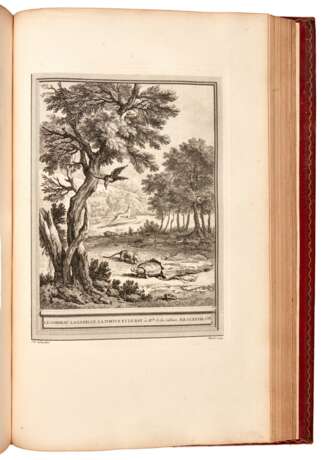ID 1076572
Lot 49 | Jean de la Fontaine | Fables choisies, Paris, 1755–1759, in a fine contemporary Swedish binding
Valeur estimée
£ 20 000 – 30 000
Fables choisies. Paris: Charles-Antoine Jombert for Desaint & Saillant and for Durand, 1755–1759
First edition, second state (lettering on the monkey and leopard banner of plate 1 for Fable CLXXII). with these illustrations, large paper copy, 4 volumes, folio (495 x 327mm.),
woodcut vignette on titles, woodcut tailpieces at the end of each fable (some repeated), frontispiece with bust of La Fontaine, 275 FINE ENGRAVED PLATES AFTER JEAN-BAPTISTE OUDRY, reworked by Charles-Nicolas Cochin and engraved by Aubert, Aveline, Baquoy, Beauvais, Beauvarlet, Cars, Chedel, Chenu, Chevillet, Cochin, Cousinet (Elisabeth), Dupuis, Duret, de Fehrt, Fessard, Flipart, Floding, Gaillard, Gallimard, Lebas, Legrand, Lemire, Lempereur, Marvie, Menil, Moitte, Ouvrier, Pasquier, Pelletier, Pitre-Martenasie, Poletnich, Prévost, Radigues, Riland, Rode, Salvador, Sornique, Surugue, Tardieu, and Teucher, without the portrait of Oudry, added later and not considered integral, CONTEMPORARY RED MOROCCO BY A STOCKHOLM BINDER, PROBABLY CHRISTOPH SCHNEIDLER, covers with ornate frame of embellished drawer-handle tools and garlands of flowers and fruit, shell cornerpieces, a bird perched at the center of the lower edge of the frame, raised bands, spine gilt in compartments with central floral spray and floral cornerpieces, turn-ins with cresting roll, marbled endpapers, gilt edges, one plate with neatly repaired tear to tail margin extending through the caption of an engraving, some leaves mildly browned, occasional light foxing
In handsome gilt bindings from a Swedish workshop, this is a lovely copy of the most deluxe version of a work Ray considers one of the three most beautiful illustrated French books between 1700-1914, as well as “one of the most ambitious and successful of all illustrated books”. According to Cohen-de Ricci, this “magnificent” work was printed on ordinary paper, medium-sized Holland paper (c.400mm. tall), large “imperial” paper, and very large Holland paper (more than 490mm. tall); the present copy is the last of these and, not surprisingly, is the rarest and most sought after (“fort rare et très recherché”).
The plates are finely engraved with a surprising degree of consistency (especially given the large number of burins at work), they are always detailed and delicate, and they are frequently alive with light. In Ray’s words, the illustrations, which feature a comprehensive view of the French countryside of the 1730s, offer a fertile world “to which thereader may return again and again for delight and instruction”.
Oudry (1686-1755), the greatest animal painter of his age, was ideally suited to illustrate La Fontaine; as Ray says, his “rendition of animals is hardly to be surpassed”. At the same time, Oudry’s interpretation “is broad and free,” and to make his 276 compositions more workable for the engraver, Cochin was called upon to turn the originals into finished prints. In doing so, he enhanced the compositions, particularly the numerous illustrations featuring human figures, and the book’s preface says that “Oudry himself recognized the new merit which his work had acquired in passing through the skilled hands of his illustrious colleague.” The meticulous creation of the engravings and the diverse array of papers on which copies were offered led Holloway to describe this edition of Fables as “the most heroic enterprise in the history of the rococo illustrated book”.
The fine bindings here, also in rococo style, might well be taken as the product of a Parisian atelier, but they were done by a Stockholm workshop employing tools identified by Hedberg as those of Swedish Court binder Christoph Schneidler (see vol. 2, pp. 102-105, fig. 34-38, notably 34V, 34Y and 38b [the bird stamp]). Son of an émigré German bookbinder, Schneidler (1721-1787) attained the status of master binder in 1746, and became the official binder to the Swedish royals in 1754. The Oxford Companion to the Book notes his “brilliant technique and eye for new fashions, such as rococo designs in the 1750s”.
| Artiste: | Jean de La Fontaine (1621 - 1695) |
|---|---|
| Catégorie maison de vente aux enchères: | Impressions, graphiques, livres |
| Artiste: | Jean de La Fontaine (1621 - 1695) |
|---|---|
| Catégorie maison de vente aux enchères: | Impressions, graphiques, livres |
| Adresse de l'enchère |
Sotheby´s 34-35 New Bond Street W1A 2AA London Royaume-Uni | |
|---|---|---|
| Aperçu |
| |
| Téléphone | +44 (0) 20 7293 5000 | |
| Téléphone | +1 212 606 7000 | |
| Conditions d'utilisation | Conditions d'utilisation |






